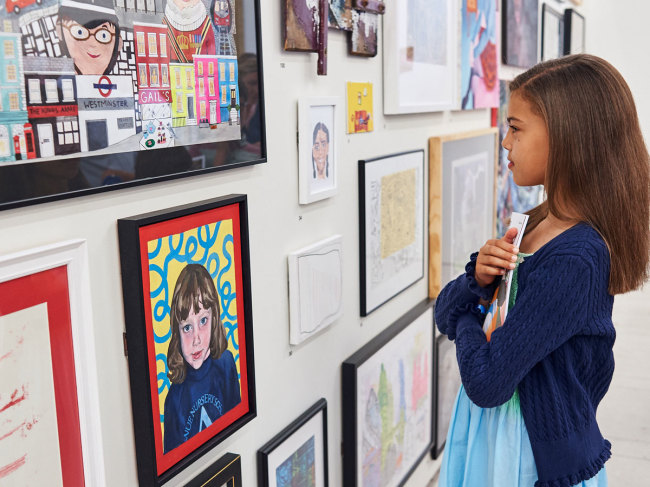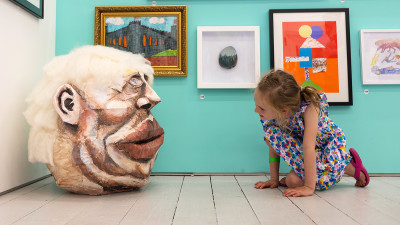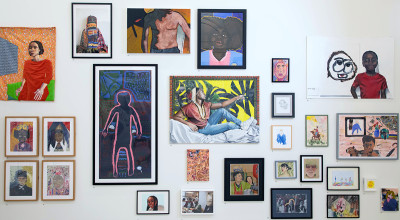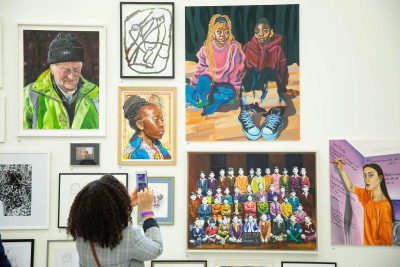Why we need to take child art seriously
Why we need to take child art seriously
By Molly Bretton
Published 27 June 2022
We need to change our attitude to children’s art, says the RA’s Head of Access, Families and Schools – as the RA’s Young Artist’s Summer Show prepares to return for its fourth year.
-
An earlier version of this article was published in 2021
“My kid could have done that” is one of the oldest art clichés around – managing to both dismiss radical new ideas and slip in an assumption that children’s art is worthless, all in one cheap shot.
We tend to be comfortable with the idea that creating art has great psychological and educational benefits for young people – and adults, of course – and so we (rightly) encourage our children to create art for those reasons. But when it comes to what they actually make, we don’t often think of it as actual “art” (short, perhaps, of the odd child star who goes viral).
Children are masters of the make believe — in their minds chairs become horses, sofas become race cars, ladders become spaceships. Put a pencil in their hands and their art is equally spontaneous and playful. But this same instinctive creativity is what leads us to treat their creations as nothing more than keepsakes, or at best a temporary update for the fridge door.
-

Joshua, Year 1, My Shells, 2020.
“I wanted to do a drawing of my shells, they are beautiful because they are all different. They also remind me of our holidays, I collected them with my daddy.”.
A4 Landscape.
-
We don’t expect to see children’s art in galleries unless it is to prove the prodigy of a famous artist, and there’s a distinct void of literature about the value of child art. That lack of visibility means that it’s hard for most of us to engage with – and that most wouldn’t even think to. Our culture just doesn’t have the building blocks for experiencing, appreciating and appraising art made by children – and that’s what we’re trying to change with the Young Artists’ Summer Show (but more on that later).
If you dig even a little into the history of art, though, you will find a long line of artists who have admired and been inspired by the unique perspective of children and their work.
Let’s go back to the 18th and 19th centuries, when Romantics such as the painter Caspar David Friedrich and writers like Wordsworth and Coleridge promoted the idea that children could see the ‘truth of nature’ thanks to their “naive” perspective on the world. In John Ruskin’s The Elements of Drawing (1857) he encouraged artists to maintain an “innocence of the eye”, a freshness of vision that he called the “condition of childhood”.
-
When I was the age of these children, I could draw like Raphael. It took me many years to learn how to draw like these children.
Picasso
-
In the late 19th century there was another peak in artists’ interests in children’s creativity. Reflecting the colonialist views of the time, primitivists such as Pablo Picasso and Paul Gauguin turned to non-Western art for inspiration as a way of breaking away from the stuffy, academic and over-cultivated Western art scene. They considered non-Western art less developed, closer to nature, and more “pure” or simple. They developed a style that they believed reflected this “simplicity”, and also looked to self-taught artists, folk art, and work made by children for inspiration. In this sense, childhood was seen as the ‘primitive’ prehistory of the adult.
Still – despite their positive view of children’s perspective and self-expression, child art was not thought of as “true art”. This was exclusively for adults, whose ability to analyse what they are doing and why they were doing it was, and still is, seen as key. This attitude hasn’t gone away; we still all too readily judge child art against our own adult standards.
-

Jago, Age 6, Coalza, 2020.
“This drawing was inspired by the tubes and railways in London and the waiting people have to do for them.”.
Charcoal. A2 Portrait.
-
As the 20th century went on, artists including Vasily Kandinsky, Joan Miró and Jean Debuffet avidly collected, studied and in some instances took quite specific cues from children’s art (which is where our kid-could-have-done-it cliché appears)
As Jonathan Fineberg describes in The Innocent Eye (1997), far from being offended by the comparison to child art, Expressionists, Cubists, Futurists and artists of the Russian avant-garde movements often encouraged the parallel and frequently exhibited their work alongside the art of children.
Roger Fry showed child art at the Omega Workshops in 1917 and 1919, and there was an exhibition of children’s art from the classes of artist Franz Cižek included in the 1908 Vienna Kunstschau. Matisse had enough interest in the drawings of his 13-year-old son Pierre that he included one in the background of his painting Woman on a High Stool.
-

Isla, Year 6, The Colourful Musical Mind, 2020.
“The painting is how I think the inside of my mind would look like if it could be taken out and painted. It has all of my different interests; sailing, gardening, swimming in the sea, parties, colour and music. It is like a puzzle that when it is looked at the viewer needs to put the pieces together in their own mind. I listened to music as I painted it. Billie Eilish and the Imagine Dragons being my favourites. Kandinsky is my chosen artist who had synaesthesia and he also used music while working on his paintings and his work has inspired my work.”.
Acrylic on canvas. A2 Landscape.
-
In a similar vein, during a tour of a 1956 exhibition of children’s art, Picasso said: “When I was the age of these children, I could draw like Raphael. It took me many years to learn how to draw like these children.” To aid in this “unlearning” Picasso often observed his children drawing and sometimes worked collaboratively with them on making drawings and doodles.
In the present day, many artists are inspired by the creativity of young people and seek to inspire that still vital child in themselves – or, as Ruskin would have said, to retrieve the “condition of childhood”. In the 1980s Keith Haring painted a number of his large banners with a teenager named LA2, and he drew one of his last series of etchings together with a nine-year old boy named Sean Kalish. In our 2019 Summer Exhibition, Bob and Roberta Smith RA displayed his painting My Son Changed My Art, which describes the inspiration he found in his son’s innate, spontaneous approach to making.
-

Bob and Roberta Smith OBE RA, My Son Changed my Art, 2018.
Sign writers paint on board. 120 x 120 cm.
-
How these artists have looked at and been inspired by the art of children is a great start. The next step is for us to celebrate it in its own right.
That means respecting children’s art as having its own distinct value, and equipping young artists with opportunities to know, understand, exchange and develop cultural expressions amongst and for themselves.
At the RA, we’re working on this. Our annual Young Artists’ Summer Show – an annual open submission exhibition with both online and physical incarnations – is designed to give children a platform. We want to show and appreciate their visions, their culture, what they value – and to allow adults to consider and develop a deeper appreciation of the value of children’s art and culture. For our 2021 exhibition, we had a record 33,000 submissions. The passion, imagination and talent is out there in our young people, and we need to celebrate it.
With us on the quest, there are a handful of museums dedicated to celebrating and promoting the importance of children’s art. One of them, The International Museum of Children’s Art in Oslo, regards children’s art as a living part of folk art and as an important element in our national and universal culture. Rafael Goldin, film director and founder of the museum summed up the need for his museum and the argument for more spaces like it to exist when he said:
“It is said that children are people. But, people do not exist without a culture. Children are people who belong to the future. And they have the right to their own culture, their own art and history.”
Children are people, not pre-people, and their creativity forms a crucial part of the diverse range of human expression. The art world is poorer when we ignore, exclude or ‘other’ aspects of creativity from our history and experience of art-making. In my view, trying to appreciate art made by children opens our minds to better understanding and respect for all art, all children, and all artists. Let’s build a richer art world that respects and celebrates children’s part in human creativity.
So, I assume we’ll see you all at the Young Artist’s Summer Show in July.
-
-

Visit the Young Artists' Summer Show 2022
19 Jul - 14 Aug 2022
Now in its fourth year, the Young Artists’ Summer Show is a free, open submission exhibition for students aged 5 – 19 studying in the UK and British schools overseas. Artworks are judged by artists and arts professionals with selected artworks displayed online and on-site at the Royal Academy of Arts.
-








